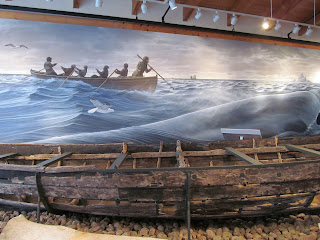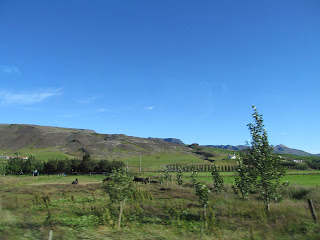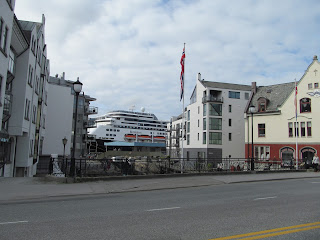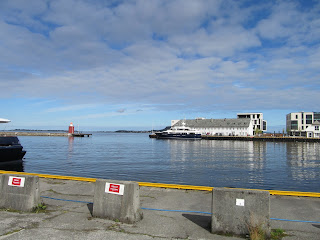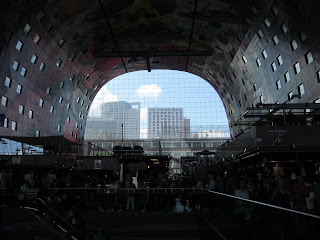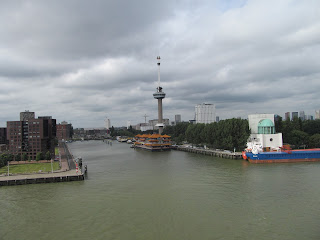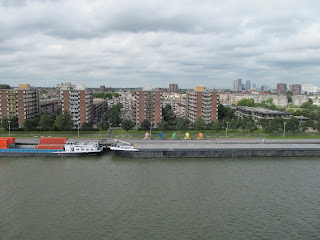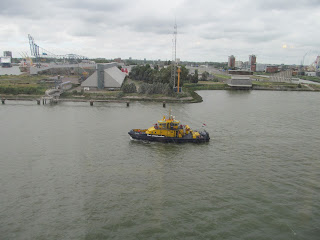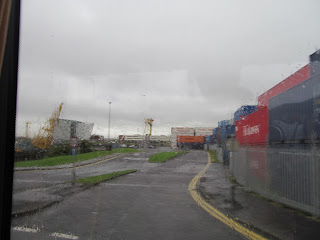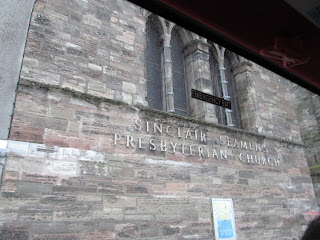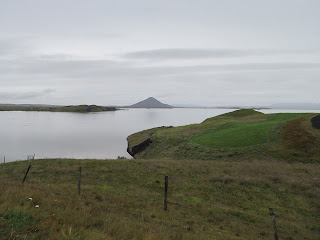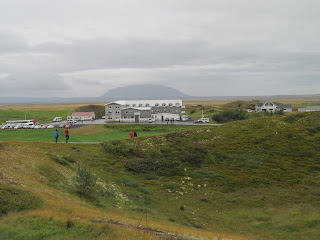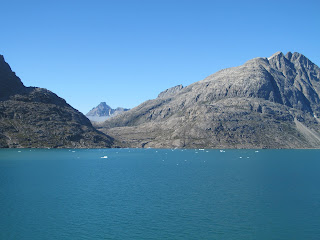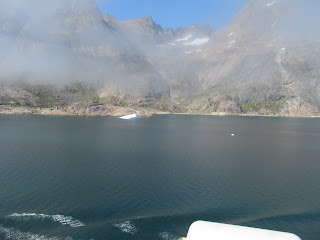CRUISE TO EUROPE---AND BACK
20 July - 24 August 2016
20 July - 24 August 2016
We
booked a Holland America Cruise aboard the Rotterdam. It was round
trip from Boston, Massachusetts and was actually two cruises back-to-back. The
cruise line called it The Voyage of the
Vikings. We were looking for a way to escape the Texas heat. We choose a
cruise based on itinerary; we decide where we want to go and then find the best
way to get there. This itinerary appealed to us for that reason.
We spent a few days in Boston before boarding the cruise on Wednesday 20 July.
On Sea Days, we had the
opportunity to attend lectures and other events, see entertainment and, of
course, eat. Since the days were much
the same, we’ll just concentrate on the ports.
Thursday 21 July - Bar Harbor, Maine
While at breakfast, they announced we were
anchored at Bar Harbor and that the ship had been cleared. We returned to the
cabin and gathered our belongings for the day. Shortly after 10:00, we joined
the crowd in the "Ocean Bar (5)" for a tender ticket. Once ashore,
we walked up and down Main Street. We mostly window-shopped but did go into
several stores.
Our final stop ashore was Geddy's for a delicious lunch.
After eating, we continued our downhill walk to the pier where we boarded a
tender back to the ship.
Saturday 23 July - Sydney, Nova Scotia, Canada
We docked in Sydney a little earlier
than scheduled. A bagpiper was skirling outside the terminal building. A huge
steel fiddle dominated the area and serves at the symbol for the town, which
once relied on coal mining and now depends on tourism.
Several shops in the
terminals sell souvenirs and crafts---some locally made. A craft show of local
crafters was set up in the exhibits hall. From the terminal, we walked up to St.
George's Church, an Anglican church occupying the oldest church building on
Cape Breton Island having been built as a chapel for the Garrison in 1785.
Inside the parish hall behind the church was another craft show. From there we
walked a few blocks and made a photo of Sacred Heart Church.
A couple of
blocks’ walk took us to Charlotte Street, the town's main street, where we went
to Cape Breton Centre for Craft and Design. We then walked back toward
the ship taking a boardwalk along the water, but detoured to St. Patrick's
Church and Museum, operated by Historic Sydney to preserve the building.
While eating lunch in the “Lido,” we saw more than a dozen sail boats enter the
harbor; several had colored sails. We think it was some sort of race as all the
boats but one went on one side of a buoy and that one boat came back to circle
that particular buoy.
Sunday 24 July
- Corner Brook, Newfoundland, Canada
Another gray day with a fairly strong
breeze under overcast skies. About 8:30, there was fog over the water. About
10:00, we left the ship and rode a Shuttle Bus, otherwise known as a yellow
school bus, into downtown Corner Brook. The stop was across the street from
City Hall. As it was Sunday, stores were not open, but we didn't see any that
piqued our interest. Some crafters were set up in front of City Hall.
We
rode the bus back to the ship and got some free laminated luggage tags from the
tourist booth. We also looked at some local crafts in a tent in the port area. Shortly
before 5:00, the Captain announced that we might be delayed by winds holding
the ship against the pier; fortunately, the ship was able to push away, turn
and sail out of the harbor on schedule.
Monday 25 July
- Red Bay, Labrador, Canada
We met in the ""Showroom" on Deck 4 at
7::20 for a 7:30 tour departure. Upon entering the lounge, we received stickers
indicating we were "Group 1 - White." Red Bay is a tender port, and
we were on the first tender ashore.
Once ashore we met Cindy, our guide, and
Frank, our driver. We boarded a tour bus and rode to the Visitors Center at
the Red Bay National Historic Site of Canada housed in a modern structure
atop the hill. There we saw a half-hour video on recovering artifacts from the
16th century shipwreck from the harbor below. It told the story of the Basque
whaling operations in the area from the 1500s as shown by documents in France
and Spain and the recovered artifacts. They harvested thousands of gallons of
whale oil for sale in Europe. We also saw the frame of an actual 16th century chalupa
[whaling boat] discovered beneath the submerged wreck.
From there we drove to
the foot of the hill to another building housing artifacts from the shipwreck;
the salt water and the local iron-rich mud preserved many of them, especially
cloth, hair and leather, excellently.
We then took a drive along the roadway.
We noticed a harsh terrain with little topsoil, many rocks and stunted trees;
tree height is limited to snow depth in many areas. Reindeer moss and other low
vegetation in various shades of green provided unexpected color on the overcast
day. After crossing the Pinware River, we arrived at the Atlantic almost at the
same place as the river's mouth. Sandy beaches abound but the water is too cold
for swimming and there is a lot of wind.
In L'Anse-au-Loup, we visited the Labrador
Straits Museum to see local women crafting: rug hooking; caribou tufting
designs; quilting; embroidery.
From there it was more coastal driving with
Cindy providing both natural and historic commentary. After seeing the Point
Amour Lighthouse across the water, we heard about the Strait of Belle
Isle separating Labrador and Newfoundland; it is only 9 miles wide at its
narrowest part.
We drove to and across the Labrador - Quebec Border and turned
around at Blanc Sablon, Quebec.
Our next stop was the Gateway to Labrador
Coastal Drive Visitor Centre in L'Anse au Clair; it is housed in the former
St. Andrew's church built in 1919.
From there we drove to Seaview Restaurant in Forteau for lunch: chicken with
Bakeapple [cloudberry or baie qu'appelle] sauce; green salad with partridge
berry vinaigrette dressing; lemon pie---maybe the best cruise-tour-lunch ever.
We then back tracked to Red Bay arriving at 3:30. The last tender was waiting
and the ship sailed shortly after we boarded.
Wednesday 27 July - Qaqortoq, Greenland
The name of this place is pronounced something
like "Kwa-Kah-Tok" and sort of sounds like a chicken; natives ashore
made it sound more guttural. When we awoke around 7:00, it was quite foggy. We
heard the fog horn a few times, and it was still foggy when we went to
breakfast about 8:30. By the time we finished breakfast, the sun had come out.
As we sailed into Qaqortoq, we saw a couple of small icebergs, and there also
appeared to be some patchy ice along the shoreline as well as in the higher
elevations. There might have been some on the mountains but it was difficult to
tell the difference between the clouds and ice at that distance.
After the ship
was cleared, we went to the lounge for a tender ticket and got "Blue
6." We waited less than 15 minutes before being called. We were surprised
to see a couple of dozen small children, probably all under the age of 8,
walking in small groups with a teacher or some other person; maybe they came
from daycare. Almost all the adults we saw looked too old to have young
children. We have no idea how people make a living here. Some could have been
out in fishing boats. A few ladies had tables of beaded jewelry and 3 or 4 men
had bone carvings. There were a couple of clothing stores, a souvenir shop and
what we think was a cafe. We walked around the colorful village making photos
of the fountain,
the church, which was locked,
and other sights.
Some of the
natural stone outcroppings contain carvings, commissioned by the village from
professional artists, as a public art installation.
While we did see a few
masonry buildings, almost all structures were wood, and we never saw a tree.
While most buildings are painted barn red; others are green, blue, orange. Some
apartment buildings have each unit painted a different color. We were probably
off the ship a little more than an hour. The air was cool, clear and crisp.
Across the sparkling water, the village shone as the colorful structures dotted
the hillside. While we were walking, one helicopter took off and another
landed; we were told this is their only air service and that they get one
supply ship each month. Having been told that everything must be brought in, we
looked and saw no garden plots, chickens, etc. It must be a difficult life.
Thursday
28 July -
Cruising Prins Christian Sound
When we awoke about 7:00, the ship was barely
moving. Shortly thereafter we entered the Farewell Islands Archipelago and
cruised it leisurely the entire morning. Temperatures in the mid-50s made going
onto the open deck to make photos easy. Barbara, location guide, provided
intermittent commentary broadcast on the open decks and in the public spaces. Brilliant
sunshine and blue skies provided a perfect backdrop for steep, dark mountains
and white glaciers and snow. Clear seas of an indeterminate color reflected sky
and landscape. After breakfast in the "Lido," we went to the
"Crow's Nest" and spent the remainder of the morning marveling at the
pristine scenery. Mountainsides in shades of gray, ocher and black were
splattered with white---some glaciers and some merely patches of snow. Green
lichen, moss and hardy grass provided occasional green. In places, water from
melting glaciers trickled, flowed, tumbled and cascaded to the sea far below.
Ice floes and bergs---in shades of white and blue---added floating features to
the enthralling landscape. A slurry of crushed ice swirled in some spots while
clumps bobbed in the ripples. Two whales, feeding and spouting, ignored the
ship. Shy seals slipped into the water as the ship neared. One arm of the sea
seemed curtained off by a fog bank while other areas remained clear. At noon we
ate lunch in the "Lido" before returning to the "Crow's
Nest." By then, the ship entered Prins Christian's Sund providing
an afternoon of more spectacular scenery. Many travel experts consider a cruise
of this marine channel as one of the most beautiful on Earth. A local fishing boat, perhaps from the
village of Aappilattoq, passed to our starboard side looking like a toy more
suited to a bathtub than the ocean. Twice the Captain stopped the vessel and
spun it 360 degrees to provide viewing for everyone.
Exiting the sound, we
entered the Denmark Straits as we sailed toward Iceland. On the horizon
off the port side we saw huge icebergs; one had a hole through it.
Saturday 30 July - Reykjavik, Iceland
Our tour tickets
showed a meeting time of 8:45 with a 9:00 departure. We were 12 Pink and left
the ship about 8:50. We boarded a green bus with Valma as our guide. Brilliant
blue skies, bright, sparkling sunshine and temperatures in the upper-50s and
low-60s were the order of the day. A perfect day for touring. Traveling through
green countryside dotted with small summer houses and farms provided a perfect
beginning to our day. Streams, rivers and lakes of crystal clear water
shimmered. Some fields held sheep, both white and black, while others had
Icelandic horses. Almost every farm had bales of hay; some was unwrapped but
most where swathed in blue, white or black plastic. Our first stop was Thingvellir
National Park where we saw the convergence of two tectonic plates, the
American and the Euro-Asian. A flag marked the site of the first meeting of the
Icelandic Parliament, the Illing, in
974.
From there we drove through more rolling countryside to Gullfoss, a
waterfall famous for rainbows formed in its spray.
Mountains, volcanoes and
glaciers lining the horizon only served to enhance our view. We ate lunch of
tomato soup and salmon in a cafe near the falls. Traversing more winding roads
took us to the Geyser Geothermal Area where one erupted for three brief
spurts, none of which we caught on camera.
Leaving that area, we stopped at Faxi
Waterfall to admire it and to see a fish ladder enabling salmon to travel
upstream.
Roads were crowded as were parking lots because it was Saturday,
because it was a beautiful day and because Monday is a bank holiday. Picnickers
and campers were everywhere with parking lots crowded and RV spaces filled. We
had front row seats at Fridheimar for a display of Icelandic horses and
their gaits. Riders were the owner and his children. The smoothness of the
gaits impressed us, and we enjoyed the presentation a lot. After the show, we
went to the stables to see Icelandic horses more closely.
At Kerid we
peered down into a volcanic crater with a lake in the bottom; it was like
looking into a funnel.
Our last stop was at Orka Nattaurannar, a power
station, which converts geothermal energy into heating and hot water for homes
and businesses.
Sunday 31 July
- Reykjavik, Iceland
We enjoyed another beautiful day in Iceland.
It was a
little cooler with temperatures in the mid-50s, a stiff breeze and partly
cloudy skies. We left the ship about 10:15 and rode the shuttle to the Harpa
Concert Hall.
Crossing the street, we walked a few blocks into the old town
center area. We window-shopped and went into several stores. We then walked
back up the hill going into several more stores. We stopped and made some photos
along the way. We continued on up the street, a pedestrian one, for another
block or two before turning around.
We made our way back to the concert hall
where we walked through a shop in the lobby
before catching the shuttle back to
the ship. At 5:00, the ship pulled away from the dock and set sail for Norway.
We could see land on the horizon from our cabin window.
Wednesday 3 August - Alesund, Norway
Because we had been here a couple of years ago, we
decided against taking a tour. With blue skies, bright sunshine and
temperatures in the low-60s, it was high summer in Alesund. P&O's
"Arcadia" was also in port today. We left the ship about 10:00 and
spent about an hour and a half walking around the downtown area and making
photos of the buildings. A disastrous fire in 1904 destroyed the town; like
most of Norway's towns, almost all buildings were wooden. Kaiser Wilhelm, who
enjoyed spending summers nearby, sent shiploads of supplies and the town was
rebuilt in the "Art Nouveau" style. Preservation has kept the
downtown area a cluster of "Art Nouveau" buildings in various colors
and decorated with both architectural elements and paintings.
We enjoyed seeing
kayakers, a small sailboat and even a waterskier in the harbor. As we set sail,
a fireboat sailed alongside spraying streams of water in salute.
Thursday 4 August - Scenic Cruising Hardanger Fjord and Eidfjord, Norway
We awoke around 7:00 and were already in the fjords.
Whether it was Hardanger Fjord or Eidfjord, which is a branch, we
never knew. We sat in the "Crow's Nest." Although bright, skies were
overcast and there was no sunshine to make the scenery sparkle. We made some
photos and listened to Barbara's commentary. Small villages hugged the
waterline and some small farms clung to the steep hillsides. Various shades of
green from moss, grass and trees provided the backdrop for buildings painted
white, red or black. Waterfalls looking like wavy white lines gushed down steep
inclines, at times disappearing under a green covering and then reappearing
below. We met one ferry and at one point the ship passed under a suspension
bridge. About 9:30, the ship arrived at the town of Eidfjord and docked.
We
went ashore in time to meet our tour. We boarded Bus #9 and actually left
earlier than the scheduled 1:30. Our tour took us out of Eidfjord and up the Mabodalen
Valley with it's beautiful scenery---more of the same with waterfalls,
glaciers, patches of snow all set in a background of green vegetation or gray
granite. It wasn't sunny, but it was bright. We finally reached the Hardanger
Mountain Plateau with its almost flat and rocky surface. There were
occasional rivers and lakes. We saw a few summer farms with a few goats, but
almost all structures were summer houses used by Norwegians; many of these structures
are not for year-round use. In one area, we saw a ski slope and what looked to
be a ski lodge. Some areas of the highway were lined with poles twelve to
fifteen feet tall which were used to guide snowplows. We enjoyed traveling over
and seeing this unusual---for us---terrain.
About half way across the plateau,
we stopped at Halne Mountain Lodge for Norwegian waffles served with
strawberry preserves and sour cream. We also had coffee and tea. At that point,
we were about 3700 feet above sea level. We made some photos outside including
the lake across the highway.
While we were there, we saw some bicyclists on the
roadway as well as a number of hikers, some heavily laden with backpacks. A bus
made a scheduled stop on the highway, loaded hikers and backpacks and continued
on along the highway. After stopping for refreshments, we began our return
journey. Soon we drove into rain, not a hard rain but more like a summer
shower. That made the stop at Sysan Dam less photogenic because
everything appeared in various tones of brown, black and gray. This dam was
built primarily of stones from a glacial moraine.
We continued our down
mountain journey with another stop at Hotel Fossli to see Voringsfossen.
By this time it was raining even more .To say the walkway to the falls
viewing area was under construction might be an understatement: there were
surfaces of wood, rock, gravel, granite, metal, asphalt, cement and ceramic.
None was really level and the rain made each of them slippery. Fortunately,
there was a fence along one side to hold onto.
After leaving the falls, we made
our way back to Eidfjord with photo stops at Hardangervidda Nature &
Wildlife Center to see goats on the sod roof and another at the Lutheran
Church in town.
We were back at the ship at 5:15 and ready for a 6:00 sail
away.
Saturday 6 August - Rotterdam, The Netherlands
We awoke in Rotterdam. It was warmer than anticipated.
We left the ship after 8:30 and made our way to bus Red 15. Pieter, 77 years
old, was our guide. We began our tour with comments about the modern
architecture of Rotterdam, which decided not to rebuild in the old style after
it was bombed by the Nazis in WWII. A drive through flat, green, farming county
lasted about 30 minutes and took us to the town of Gouda [How-duh]. We walked
from the bus along a canal hearing of historic houses and architecture until we
reached the Market Square.
Pieter set the meeting time under the
glockenspiel
on the 15th-century Gothic Town Hall.
We then
followed Pieter to De Sint Janskerk [St. John's Church] dedicated
to St. John the Baptist. We saw how the
medieval houses were built around the church and the small courtyard, which is
still in the same shape as the church. After a stop in the garden of an old
hospital,
we crossed the small courtyard to the church itself where he paid our
admission. We went inside and looked around making photos of the stained glass
windows. Parts of the church date to the late-13th century and some of the
stained glass to the mid-16th century. A small chapel contains 16th-century
windows from The Monastery of the Regulars where Erasmus was ordained.
They were brought to this church in 1580. Someone was tuning the organ and a
monitor near the elaborately carved wooden pulpit showed us the keyboards and
what he was doing.
Leaving the church, we returned to the Market Square and
walked around it. Many items, including huge wheels of cheese, were for sale.
A
calliope played.
We made pictures of De Goudse Waag, the old house where
cheese was weighed for both accuracy and taxation,
before following Pieter back
to the bus. On the drive back to Rotterdam, we saw sheep, horses and dairy
cattle on the green farms. While not totally clear, the sun shone brightly and
it was around 70 degrees. Once back in Rotterdam, we looked at more modern
architecture before returning to the ship about 12:45.
After lunch, we rode the
free shuttle into the city and walked through both the Saturday market, where
anything and everything seemed to be available, and through the Market Hall before
returning to the ship.
Sunday 7 August - Rotterdam, The Netherlands
All passengers were required to take their passports
into the terminal for a face-to-face with Immigration and get stamped out of
the Schengen Area. We could have taken the free shuttle back into town but knew
stores didn't open before noon and that the shuttle went to the same place as
yesterday, so we decided against it. While today's temperature was almost as
warm as yesterday, it was totally overcast all day. At 3:00 we had another Emergency Drill. Just as the drill ended, a
band in Dutch costumes set up on the pier and began to play. For once, we were
in the right place at the right time and simply moved to the rail to stand and
enjoy. We stayed on deck and enjoyed the music.
Then we briefly returned to the
cabin before going topside on Deck 9. As this is the Rotterdam's last
time in her home port this year, there were many three-peat blasts from the
ship's horn in salute; these were reciprocated as we sailed out to sea. We
enjoyed the scenery from the deck and also from the "Lido."
Monday 8 August - At Sea
We took our passports for a face-to-face with UK
Border Force
Sunday 7 August - Rotterdam, The Netherlands
All passengers were required to take their passports
into the terminal for a face-to-face with Immigration and get stamped out of
the Schengen Area. We could have taken the free shuttle back into town but knew
stores didn't open before noon and that the shuttle went to the same place as
yesterday, so we decided against it. While today's temperature was almost as
warm as yesterday, it was totally overcast all day. At 3:00 we had another Emergency Drill. Just as the drill ended, a
band in Dutch costumes set up on the pier and began to play. For once, we were
in the right place at the right time and simply moved to the rail to stand and
enjoy. We stayed on deck and enjoyed the music.
Then we briefly returned to the
cabin before going topside on Deck 9. As this is the Rotterdam's last
time in her home port this year, there were many three-peat blasts from the
ship's horn in salute; these were reciprocated as we sailed out to sea. We
enjoyed the scenery from the deck and also from the "Lido."
Monday 8 August - At Sea
We took our passports for a face-to-face with UK
Border Force
Tuesday 9 August - Dublin, Ireland
We walked out on the top deck
and thought it seemed cool and windy. We returned to the cabin and tried to
decide how warm it might be. When the "Ship's Cleared" announcement
came, it stated the temperature as 59 and a forecast for more sun and warmer
temperature. We didn't take coats when we went to the "Showroom" at
8:15 to meet the tour. Not a wise choice. Tony drove our bus and Georgina was
our guide. She talked about changes in the port area as warehouses are being
demolished to make space for containerization [container storage space]. As we
drove from Dublin, we saw their Calatrava Bridge which has a support in a harp
shape. Once on a motorway, we made good time because there wasn't much traffic.
Perhaps this was due to so many people being on holiday. Georgina informed us
that traffic could be quite "congealed" during regular business days.
We left the city behind, turned off the motorway and drove into the Wicklow
Hills which is a rural area of farms, woods and villages. Ireland claims to
have 40 shades of green in its landscape, and all were visible today. We
enjoyed seeing green fields bordered by hedgerows, many of which had sheep,
cows or horses. Each village seemed to have a colorful pub and a stone church.
Georgina provided information on the area and on all the villages; she
interspersed this with stories of fairies and leprechauns as well as other
Irish superstitions and culture.. It took more than an hour to reach our first
stop, Glendalough, site of an old monastery, now in ruins, established by
St. Kevin. A Visitor's Centre and a Hotel are located just outside the ruins.
We entered through a couple of stone archways built of granite and slate while
an Irish piper skirled nearby. The most impressive feature might be the
restored round bell tower with its seven floors and seven windows; the interior
stairway makes seven turns between bottom and top. A cemetery, many of the
stones too weathered to read, fills the area occupied by monks about a thousand
years ago. Ruins of a roofless cathedral and a church once called St.
Kevin's Kitchen add to the site.
Georgina provided history and other
information as we walked through the site and then gave us about 40 minutes to
"mooch around" on our own. It was overcast, cold and windy. We looked
into a nearby craft shop. At 11:00, we boarded the bus for about a half-hour's
drive to Ballyknocken House & Cookery School.
We were welcomed by
Catherine Fulvio, owner and chef.
She definitely "kissed the Blarney
Stone," and her stories were interesting. Catherine is Irish and her
husband is Italian. She then demonstrated making both Irish Soda Bread and
Sweet Scones
After the demonstration, we went to the remodeled barn to enjoy
both Soda Bread and Scones with butter and rhubarb-ginger marmalade. Tea and
coffee were served.
After eating, we returned to the bus and settled in for the
hour's drive to the ship, which took us through an area called The Glen of
the Downs. Once again we drove by the seaside and the Soft Sands area;
the tide, which we thought was all the way out when we passed earlier, was even
lower. It probably began to come in about 2:00 soon after we arrived at the
ship.
Not wanting to go into Dublin City Centre, we reboarded.
Wednesday10 August - Douglas,
Isle of Man, UK
Today was a tender port, so we
went ashore a few minutes after 10:00.
It was rough boarding the tenders with
lots of fluctuations between tender and platform. Fortunately, a pontoon
platform provided easy access at shore side. Once ashore, we wandered the
downtown area. The promenade is lined with small hotels such as Miss Marple
frequented. Although the architecture interested and intrigued us, many places
were vacant.
After eating lunch, we sat in the terminal and waited for our
tour. We boarded Bus 18 and had Neal for a driver and Frank as a guide. It
rained.
We had some difficulty appreciating the landscape though the blurry
windows but did see the Castle in Castletown.
When we got to the village of
Cregneash [sort of an open-air museum], Frank strongly discouraged our getting
out; some did; we did not. Instead, we rode to the tip of the island where we
made photos of an island, Calf of Man,
and saw a couple of seals before
returning to pick up those who walked down to Cregneash. We saw horses,
numerous sheep [many still had paint on their backs from the recent shearing;
dairy cattle---both Jersey and Holstein---and many bales of hay; beef cattle,
some of which were "Belted Galloways," also known as Oreo Cows
because of their black and white coloring, but we also some red and white ones
with the same marking. Frank told us about the territory but it was difficult
"to see that house just there through those trees at the top of the
hill," or "that stone embedded in that wall," etc.
We did see an
ancient standing stone in one field and the site of an ancient settlement near
Braaid in the Fields of Heaven.
Interestingly, many Methodist chapels
dot the island; some are no longer places of worship but have been converted to
other uses. Toward the end of the tour, we saw the grandstands and drove a
portion of the route of the motorcycle race known as the TT.
From there
we drove through Douglas itself and back to the terminal; we had made a circle
on the lower part of the island but had not driven the highest roadways because
of the fog, drizzle and poor visibility. We boarded the tender for another
bumpy ride and extremely harrowing reboarding of the ship.
We were Yellow 2 and
one of the first tours called. It was overcast and drizzling as we boarded the
bus. Gregory was our driver and Colin our guide. We did a driving tour of the
city with Colin pointing out the sights.
One of them was Leaning Albert
Clock, a memorial to Prince Albert, which has foundation problems. We also
saw the various court buildings and Colin pointed out church spires. We drove
out to Stormont, the seat of the government, where their legislative
bodies meet. Situated at the top of a hill at the end of a long driveway, the
white 1930s structure impresses. Luckily, we were able to drive to the front to
make photos.
From there we returned to the city itself. We saw the Titanic
Quarter containing the Titanic Museum, the Harland & Wolff
Shipyards, Sampson and Goliath [the giant cranes].
We were very impressed
with the City Hall; it serves as the city's centerpiece.
One of their
most famous sculptures, The Beacon of Hope, is an angel; locals call it "the doll on the
ball."
Colin talked at length about "the troubles" and we drove
into the Shankill Area where a lot of violence occurred. Now covered
with graffiti and murals, the wall erected by the British Army serves as a
reminder; for some, it is now art that symbolizes peace, but some don't see it
that way.
Shortly after passing Queen's University,
we reached Ulster
Museum where we spent a couple of hours. The museum contains 5 floors of
varied exhibits. We enjoyed seeing some of the highlights: The Kildare
Toilet Service, the most complete silver gilt toilet set remaining today;
The Malone Hoard, a unique collection of Stone Age polished axes;
Ammonite Fossils; Belleek; Takabuti, an Egyptian mummy unwrapped in 1835
and on display ever since. There are quite a few dinosaur skeletons, one
of which is a deer with massive antlers.
We also saw other skeletons and some
models of how prehistoric Irish lived.
One gallery displayed a jewelry
collection and another some religious items.
A well-lighted display of minerals
served as eye-candy.
We didn't care for the artwork. Almost everyone in
the group was waiting to leave a good twenty minutes earlier than the meeting
time. One reason could have been the large number of small children in the
museum. This display was in the museum lobby.
By this time, the drizzle was gone but there was a very cool breeze
with a temperature about 55 under overcast skies. After the museum, we dropped
some people off in town before returning to the ship. After lunch aboard ship,
we got our coats and then rode the shuttle bus into town. After walking around
the area for about an hour, we stopped to make photos at the Titanic
Memorial. There is a marble statue erected shortly after the disaster and
behind it is a monument erected on the centennial, which lists every victim's
name alphabetically.
We made some photos of the building and noted a large
screen showing the Olympics set up on the lawn. After returning to the Visitor's
Centre located directly across the street from City Hall, we rode the next shuttle bus back to
the ship.
Sunday 14 August - Akureyri, Iceland
The ship was docked in Akureyri before 8:00; We met our
tour and were Pink 4 with Solvang as our guide. The day was totally overcast
but bright. It was about 60 degrees and felt cool but not cold. We were told it
was a typical summer day in Iceland. We drove through the city itself and
crossed the fjord on a bridge.
We drove over the very steep Vikuskard Pass, where
construction on a tunnel through the mountain was in progress, to enter the Frijoskadalur
Valley. Our route was a portion of
Highway 1, which encircles the entire island. We were in the portion of
northern Iceland that contains most of the arable land. Putty-colored mountains
in shades of gray, black and brown and topped with white, cream, bluish and
grayish glaciers and snow splattered, splotched and drippy tops provided the
upright background to pastures and woodlands in multiple shades of green. Where
there was no vegetation, basalt and lava predominated. The Iceland of a thousand
years ago had trees, most of which were used for construction and fuel. Modern
Iceland invests heavily in reforestation programs, primarily spruce, but some
native birch trees remain. Even so, we think we spent part of the day above the
tree line. Streams of sparkling and clear water seeped, trickled and cascaded
twistingly through the landscape. We saw quite a few farms. Some farms had a
few beef cattle and others had dairy herds, mostly Jersey or Guernsey. We saw a
few Icelandic horses. White sheep dotted the hillsides, valleys and even the
mountainsides, not in flocks as we expected but in small groups of three to
ten. Solvang, who grew up on a farm, told us that lambs are born in May and
that the sheep are turned out to grazed the mountainsides from June to
September when they're rounded up. This is a cooperative effort with farmers
using ear markings to determine ownership. As expected, many rolls of hay
dotted meadows or were stacked near farm buildings. We learned this is grass
hay, not grain, and they expect two or three cuttings each year.
Our first stop
was Godafoss, an impressive waterfall which was really three falls
side-by-side. Viewing was excellent and we enjoyed seeing and hearing as the
river poured over the precipice and downstream. We stopped at a nearby gift
shop.
From there we rode to Lake Myvatn where we saw Skutustadagigar,
craters formed by explosions that occurred when hot lava came in contact
with wetlands.
We ate lunch at 11:00; we didn't particularly care for the trout
and glorified tater tots. After lunch we drove to an area of lava outcroppings
resembling piles lava formed much like sand castles on a beach. Known as Dimmuborgir,
it reminded us of the lava fields we walked in Hawaii but was much rougher
and taller as it looked like handsful of lava thrown around until it stuck in
globs.
From there we could see steam rising as it was only a short drive to Namafjall
Hverir, an area of bubbling mud pots with some spewing streams of hot
water. The smell of sulphur filled the air.
Solvang pointed out a gap in the mountains showing where the American and Eurasian Tectonic Plates meet.
From there, we turned around and
drove back to Akureyri, arriving a few minutes after 3:00.
As the ship sailed out
of the fjord, we saw several whales---probably Minke---spout as well as a few
fins.
Monday 15 August - Isafjordur, Iceland and Scenic Cruising Isafjordur
Isafjordur is a town in northwest Iceland and is on that part of the island
that sticks out like a giant crab claw. It was a day much like yesterday,
totally overcast and cool, except there was much more moisture in the air. We
left the ship about 9:15 to walk into town. As we left the port, we realized we
were docked at the head of the fjord and surrounded by a steep wall of
mountains on three sides.
We saw quite a few containers on the pier even though
fishing is said to be the main industry here. Leaving the ship, we walked along
the water until we reached the Museum and then turned right toward the
shopping area. We saw some fishing boats before stopping at the Tourist
Information Center. From there, we continued walking along the streets;
several cafes and bakeries as well as shops lined the street. We looked into a
bookstore, the post office and some stores selling crafts and souvenirs. There
was even a one-stop-does-all needlework store selling yarn, cross-stitch,
needlepoint, embroidery, etc.; it even had an embroidery machine for custom
work.
We made photos on our walk and were back aboard ship about 10:30.
Although it's a small place, it had more than we expected although we didn't find
the locals as friendly as in other Icelandic ports. Later we noticed another
stand had opened on the pier, so we decided to go there. It was sprinkling rain
by that time, but we only got damp. We found nothing but were amused at the
vendor hurrying to move his sheepskins inside. Didn't they get wet in the wild?
Tuesday
16 August -
At Sea
We were sailing what is known as The Denmark Straits, site
of intense naval activity during World War II. The Captain altered course some
to sail directly over the wreckage of the HMS Hood and sounded the
ship's horn for 10 seconds in tribute.
Wednesday 17 August - Cruising Prins Christian Sund
We awoke to fog. At first, we
thought it was mostly condensation on the cabin window, but we looked on the TV
channel at the ship's camera and confirmed it was fog. As today's itinerary was
scenic cruise in Prins Christian Sund, the day did not look promising.
That sound is a passageway that runs along the Southern coast of mainland
Greenland; today we had the mainland on our Starboard [right] side and islands
on the other. Barbara began commentary from the Bridge a few minutes after
8:00; she said there was sunlight ahead. We tried to find a viewing area. We
thought we had one in the "Crow's Nest," but they closed a third of
the space for a private function. We wound up in the "Lido,"
starboard side, in chairs facing a window. We stayed there until moving to a
table at noon to eat lunch; after lunch we returned to the window. It was also
convenient for making photos outside on the rear deck; the other choice was
through the dirty windows, and we made some of those, too. As there is nothing
for comparison, the scale of the scenery doesn't show up in photos. Just as we
reached the Weather Station,
the ship sailed through the summer fog bank
and out into sunshine drenched scenery. Mottled brown granite mountains
provided the backdrop for the landscape. Multiple shades of brown from
chocolate to cafe au lait held snow. Glaciers and snow patches, many more
silvery gray than white, looked like globs of crème thrown by a giant hand.
Some were atop the mountains; some clung to the sides; others seemed to ooze
and dribble down toward the deep emerald water. In some areas, tidewater
glaciers reached the water's edge with their blue crinkled edges providing
contrast and making their ice look really while. Swirls of slushy looking ice
topped the water where the glaciers touched. In one place, a receding glacier
left silt, like a brown scum, atop the water. Ice bergs In various sizes
floated. Reindeer moss covered many mountain surfaces. Waterfalls, many of them
just sparkling lines, snaked their ways down mountainsides; some of them seemed
to disappear into the rock before reaching the water's edge while others gushed
at sea level.
We saw a whale, possibly two, blow and also saw a seal swim by
the ship. Twice the captain stopped the ship and pivoted it 360 degrees to
provide everyone a view. As we neared the end of the sound itself, we saw
Aappilattoq, a small village, in a semi-protected cove.
We began to pick up
more fog, not just the ribbon-like bands which had decorated the passage. Here
the mountains changed into peaks so jagged they looked as if taupe-colored,
Indian arrowheads had been placed point-up into an irregular line.
Leaving the
sound, we headed into the Labrador Sea---lots more fog here. We went to
the Indonesian Crew Show. Dense fog shrouded everything " about
6:00. It cleared, or we sailed out of it, so we took the camera and went to the
"Crow's Nest" to make photos of a Gold Mine.
The ship entered
a fjord and we saw several large icebergs and a dock. Evidently, the dock, the
only manmade structure visible, is used by the gold mine to load ore onto a barge,
which is towed to Canada for refining. There was no commentary. The ship turned
around and we sailed out, maybe back into the Labrador Sea.
Thursday
18 August -
Nanortalik, Greenland
By 6:00 am, we were already anchored off Nanortalk
[nah-NOR-ta-lik], a village of a few hundred people on an island in Tasermiut
Fjord in Greenland and the country's 10th largest settlement.
This was our third Greenland port having been in Nuuk, the capital, on the
mainland ten years ago and in Qaqortaq on the 27th of July. About 9:00 we went
to the "Ocean Bar" for a tender ticket to go ashore. It took a while,
and we didn't leave the ship until around 9:30. It felt colder than the 43
degrees we were told, but the wind was blowing. Supposedly, Nanortalik's
climate is considered a mild one for Greenland because the average annual
temperature ranges from -3C (27F) to 6C (43F). A sailboat with a massive mast
was docked snug against the pier and containers were stacked in another area.
The red helicopter, part of Air Greenland's scheduled service, came and
went. Once ashore, we wandered around the small settlement looking at crafts in
small booths and going into the Tourist Information Center.
Walking
through the small town was interesting and we made some photos. We marveled at
the huge chunks of rock jutting from the ground and at how the houses were
positioned around them.
Across from the red school
and near the church was a
memorial with an anchor; a wreath had been placed on it.
The church was unusual
on the exterior but no photos were allowed inside.
By the time we had reached
the church, we had walked about as far as we wanted to, so we turned around and
went back to the pier where we boarded the tender. Most of the residents we
saw, including numerous children, appeared to be Inuit. Fishing, crab fishing
and seal hunting comprise the main industry but the gold mine only 30 km away
may change that. We enjoyed seeing the islands in the archipelago as we made
our way to the Labrador Sea. Some really large icebergs appeared among
the islands, and we tried to determine how large the above-water-portion was,
finally deciding several were as big as a house.
Saturday 20 August - St. John's, Newfoundland, Canada
We watched as we sailed
through The Narrows and tied up at the pier in St. John's, Newfoundland,
Canada.
The lighthouse at the harbor's entrance was operational as we sailed
past. We made a few photos from deck 3. We disembarked and were greeted by a
pair of RCMP
and a lady with a "Newfoundland Dog."
Next, we got a map
and some rudimentary directions and set out to walk. A young lady kindly told
us how to find an inclined walk instead of having to climb a long flight of
steps. We walked along Harbour Drive and then up to Water Street. We enjoyed window-shopping
and went into a few shops. From one lady, we learned that we needed to climb
one more block to Duckworth Street. We walked along it finally reaching the
"Sheraton" at the hilltop; "Devon House Craft Centre" was
across the street. We looked around inside and started back down the hill.
Remembering we had passed a store selling gelato, we returned to it and bought
some to eat sitting at a table on the sidewalk in front of the store. Then we
slowly made our way back toward the ship, looking into shop windows, going into
some shops and making photos; the Courthouse is a granite Victorian
structure;
the gothic Anglican Cathedral of St. John the Divine and the Basilica
Cathedral of St. John the Baptist jut from the hillside;
The Rooms, the
local museum, almost dominates the hillside in colors of yellow, green and
red.
One interesting feature of the city
is Jelly Bean Row, brightly painted wooden row houses; they appear to be
an unofficial symbol and representations are available in every shop and on seemingly
endless items.
After reboarding the ship, the sun came out, and we made more
photos of the city from deck 8. Cabot Tower atop Signal Hill was
clearly visible on one side of The Narrows.
We sailed at 8:00. We
returned to the cabin after we passed The Narrows. The lighthouse beacon
disappointed because we thought it too dim to be effective. We also skipped the
Traditional Bagpipe Sailaway at 7:30 in the "Crow's Nest."
Monday 22 August - Halifax, Nova Scotia, Canada
It was sunny as we sailed into
Halifax Harbour around 6:00.
Shortly before 8:00 clouds covered the sun and overcast skies were the order of
the day. The Veendam sailed in and tied up in front of our bow abut the
time we disembarked. After getting a map and some basic directions from someone
on the pier, we walked along a wooden boardwalk known as Harbourwalk; the
area is known as Halifax Seaport. Cool temperatures and a breeze, made
it pleasant. We looked into Dockside Shops, which is a market with
booths---think antique mall configuration; the sign said it's only open on days
cruise ships are in port. We also looked into the gift shop for the Maritime
Museum of the Atlantic. We chose not to go into the museum itself. From
there we retraced our steps to the terminal and passed it. We stopped in the Farmer's
Market, which we were told sells fresh produce on weekends. Today, some
crafts were for sale in a few spaces.
We exited the building and continued on
the walkway making photos: Cunard;
Immigration;
Acadian Dispersal.
Photos
of a pay phone
and of a sculpture made of bicycles at a restaurant called the Bicycle
Thief added to the quirkiness.
We enjoyed the walk and the seeing the shops
and restaurants along the way. Of all the places we did not expect to see a
barefooted man sitting on a bench and strumming The Old Gray Mare, She Ain't
What She Used to Be, Halifax ranks near the top---but he was there. After a
while, we turned back toward the ship. For a while, we sat on a bench and
watched people and boats. We saw Theodore
Tugboat sailing around the harbor; it’s from a TV show for children.
After
sailing, fog was thick; the foghorn blew; only the water below was visible. It
was like being inside a mister.
Wednesday 24 August - Boston, Massachusetts














































